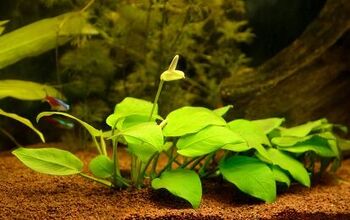5 Plants Picks for Your Brackish Aquarium

When it comes to choosing a type of aquarium to cultivate, your two main options are freshwater or saltwater. What you may not realize, however, is that there are several subcategories that branch off from each of these options – there is also an option that bridges the gap between the two. This is called a brackish aquarium. Brackish aquariums are fun and challenging to cultivate but it can be difficult to turn one into a planted tank because most plants do not tolerate salt.
Related: Top 5 Freshwater Fish Species for Planted Tanks
What is a Brackish Aquarium?
A brackish aquarium is a type of tank that walks the line between freshwater and saltwater. In the wild, brackish waters are typically found in areas where freshwater mingles with saltwater. Examples of brackish environments include estuaries, backwater areas, and mangrove swamps. While there are plenty of live plants that grow in natural brackish environments, it can be tricky getting aquarium plants to thrive in a captive brackish environment. Many plants are hardy enough to tolerate low levels of salt, but you may need to acclimated them slowly rather than simply plunging them into a brackish tank.
Related: Top 5 Fast-Growing Aquarium Plants for Planted Tanks
Best Plants for Brackish Tanks
Before you set up your brackish tank you need to think carefully about the types of inhabitants you will cultivate – this includes fish and invertebrates as well as plants. Your best bet is to start by choosing a few species of brackish aquarium fish that have similar needs in regards to the tank environment. Once you’ve decided what fish you want to keep you can customize the conditions in your tank accordingly. After you have done so, you can think about adding some live plants that will thrive in the same conditions. Here are a list of plants that can be acclimated to a brackish environment:
- Vallisneria: There are several vallisneria species that will do well in brackish tanks because they are hardy. Vallisneria spiralis and Vallisneria Americana are two excellent options for a brackish tank as long as you keep the temperature between 60 and 85 degrees. These plants do not require intense lighting, though they do need nutrient-rich substrate.
- Anubias: Most Anubias species are slow-growing plants but they are also highly adaptable to different tank conditions. Anubias barteri, for example, can thrive in any level of lighting and nearly any water conditions as long as nutrients are available. This species has tough leaves and it grows well in temperatures between 70 and 85 degrees.
- Cryptocoryne: Most Cryptocoryne species are highly adaptable which makes them a great choice for the brackish tank. These plants tolerate low lighting and they can adapt to water temperatures between 68 and 85 degrees. Cryptocoryne undulate and Cryptocoryne wendtii are examples of two species that do well in brackish tanks as long as nutrient-rich substrate is available.
- Sagittaria: These plants produce arrowhead-shaped leaves and they can grow up to 24 inches tall – they are particularly well-suited to an open-topped marsh tank. Sagittaria plants require moderate to bright lighting and they need nutrient-rich substrate, ideally with iron supplementation. Sagittaria lancifolia and Sagittaria subulata are examples of two species that do well in brackish tanks.
- Mangrove: Mangroves typically grow in brackish marshes, though they can also grow in total saltwater. These plants can be grown in substrate or rooted to an object because the plant will simply produce roots long enough to find nutrients. The only thing you need to be aware of with mangroves is that they cannot survive completely submerged – the leaves must be above the water surface.
Keeping a brackish tank can be challenging because not all fish or plants will do well in a brackish environment. In order to ensure success, be sure to do your research before setting up your tank so you know that your fish and plants will be able to handle a little salt in the water.

Kate Barrington is the loving owner of two cats (Bagel and Munchkin) and a noisy herd of guinea pigs. Having grown up with golden retrievers, Kate has a great deal of experience with dogs but labels herself a lover of all pets. Having received a Bachelor's degree in English, Kate has combined her love for pets and her passion for writing to create her own freelance writing business, specializing in the pet niche.
More by Kate Barrington























